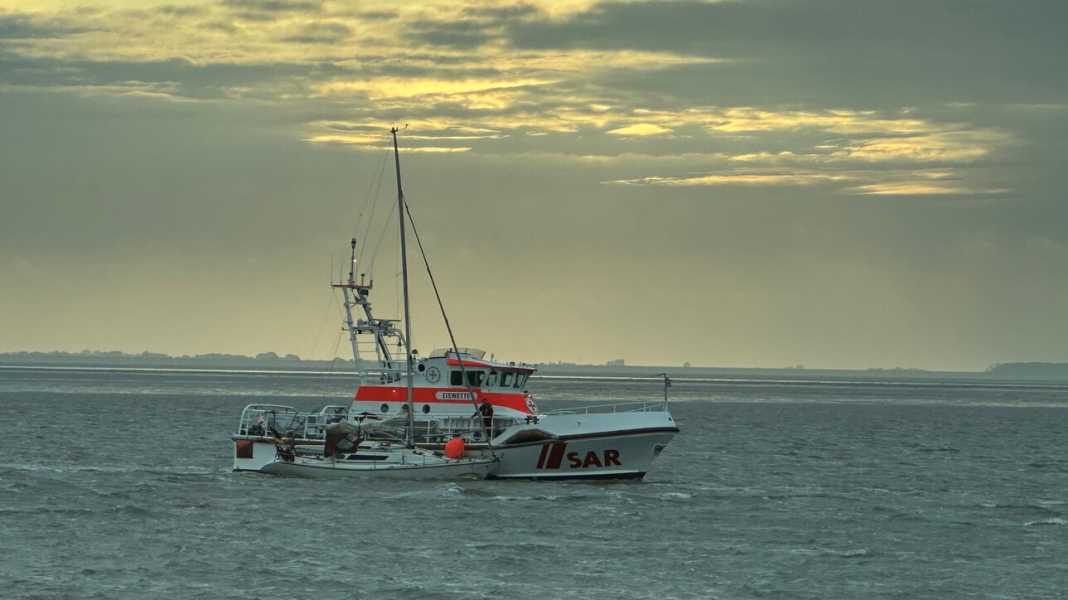
On Friday morning, an emergency call reached the DGzRS Maritime Rescue Coordination Centre in Bremen: A sailing yacht about nine metres long was drifting in the Wadden Sea, around ten nautical miles west of Westerheversand, unable to manoeuvre due to rudder damage. There were four people on board, three of whom were suffering from severe seasickness. The DGzRS immediately alerted the sea rescuers from the Nordstrand station, who set out with the rescue cruiser "Eiswette".
Difficult conditions on site
When the rescuers reached the stricken vessel, there were heavy seas with waves up to two metres high and a north-westerly wind of force 6 to 7. Several attempts to establish a stable line connection initially failed. The unmanoeuvrable sailor was lurching heavily under tow, and various cleats to which the tow rope was attached also tore out on board. Even the rescue cruiser "Ernst Meier-Hedde", which was called to assist, was initially unable to establish a permanent connection.
Dramatic evacuation by helicopter
Meanwhile, the condition of the seasick crew members deteriorated. In the choppy seas, it was not possible for the rescue cruisers to pick up the people safely. In order to bring the sick people ashore as quickly as possible, the sea rescuers requested a SAR helicopter from the German Navy. The helicopter crew eventually winched all four people off board. The skipper was first put down on the "Ernst Meier-Hedde", while the others were brought ashore.
Salvage of the damaged vessel
After successfully evacuating the crew, the sea rescuers concentrated on salvaging the unmanoeuvrable yacht. In a further attempt, they managed to take the ship in tow and pull it a little way under land. There the line broke again. Due to the land cover, however, the swell had subsided noticeably so that the "Eiswette" was able to take the disabled vessel alongside and tow it into the harbour of Strucklahnungshörn.
Seasickness as a danger
The dramatic scene illustrates how dangerous seasickness can be at sea. It is a type of motion sickness (kinetosis) and is triggered by contradictory sensory impressions. While the organ of balance in the inner ear registers movement, the eyes see a solid cabin ceiling below deck, for example. In response to these unfamiliar sensations, the body releases stress hormones, which leads to nausea and dizziness.
Experts recommend various measures to prevent seasickness. These include avoiding histamine-containing foods before and during the journey, as histamine is one of the triggers. Instead, light, stomach-friendly foods such as bananas, fresh fruit and vegetables and rusks are recommended. Getting enough sleep and spending time on deck with a view of the horizon can also help. If seasickness has already set in, home remedies such as ginger or vitamin C can have a soothing effect. In severe cases, medication can also be used, although side effects must be taken into account.
Tips against seasickness:
- Avoid foods containing histamine: tinned food, alcohol, red wine, cocoa, chocolate, tea, seafood, nuts, tomatoes, strawberries, pulses, citrus fruits, cheese, soya, yeast and wheat products
- Recommended foods: bananas, fresh fruit and vegetables (no citrus fruits), raw carrots, soups, rusks, camomile, peppermint and ginger tea
- Go on a well-rested cruise, take a nap on board
- Stay on deck with a view of the horizon
- Distraction from tasks such as steering or navigating
Home remedies:
- Ginger: as tea, candied or in capsule form
- Vitamin C: 1-2 grams daily, as a dietary supplement or in food
- Acupressure wristbands: controversial effectiveness, possibly placebo effect
Medication:
- Active ingredients: scopolamine, meclozine, dimenhydrinate, cinnarizine
- Forms: Chewing gum, tablets, plasters
- Important: note side effects, medical advice recommended

